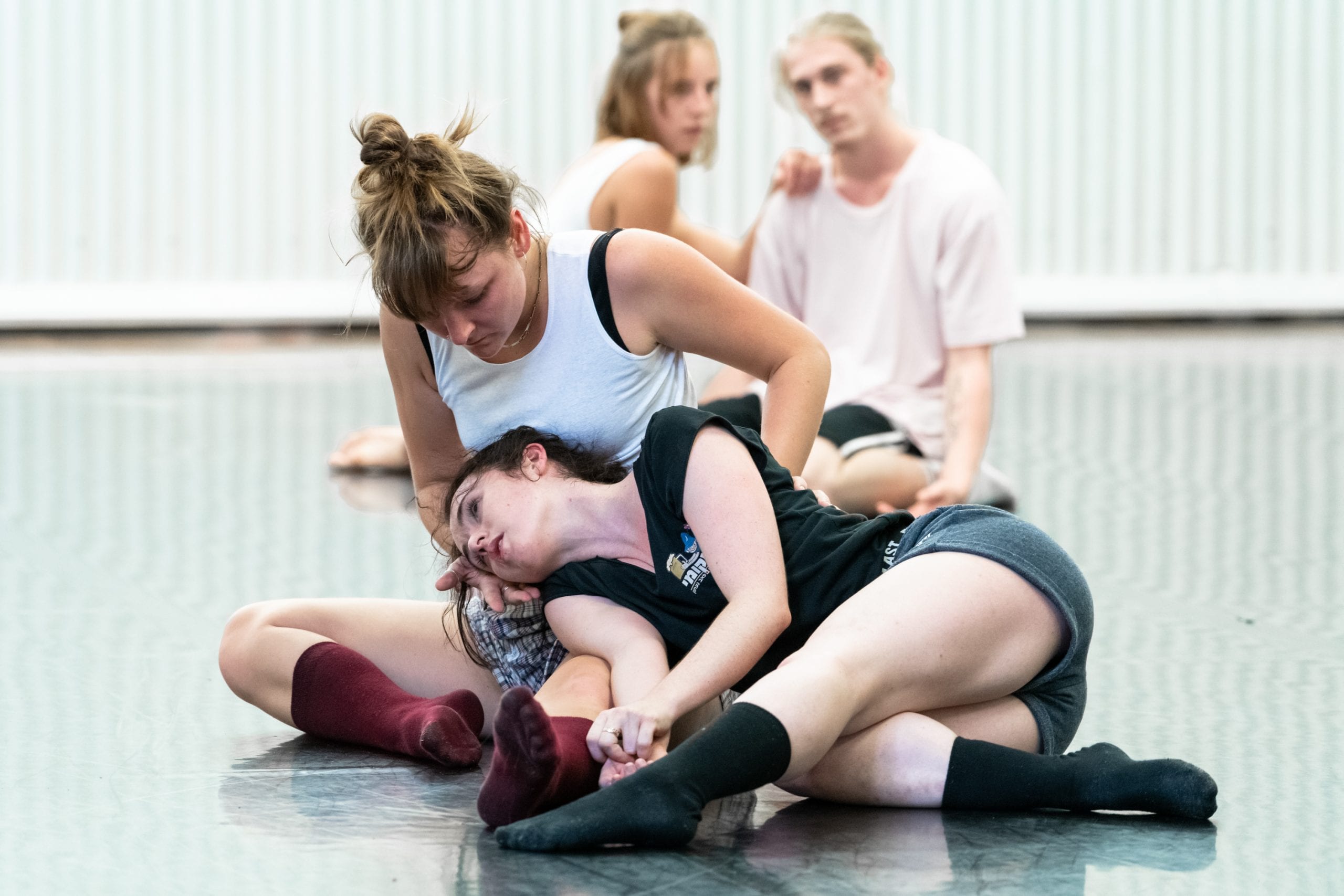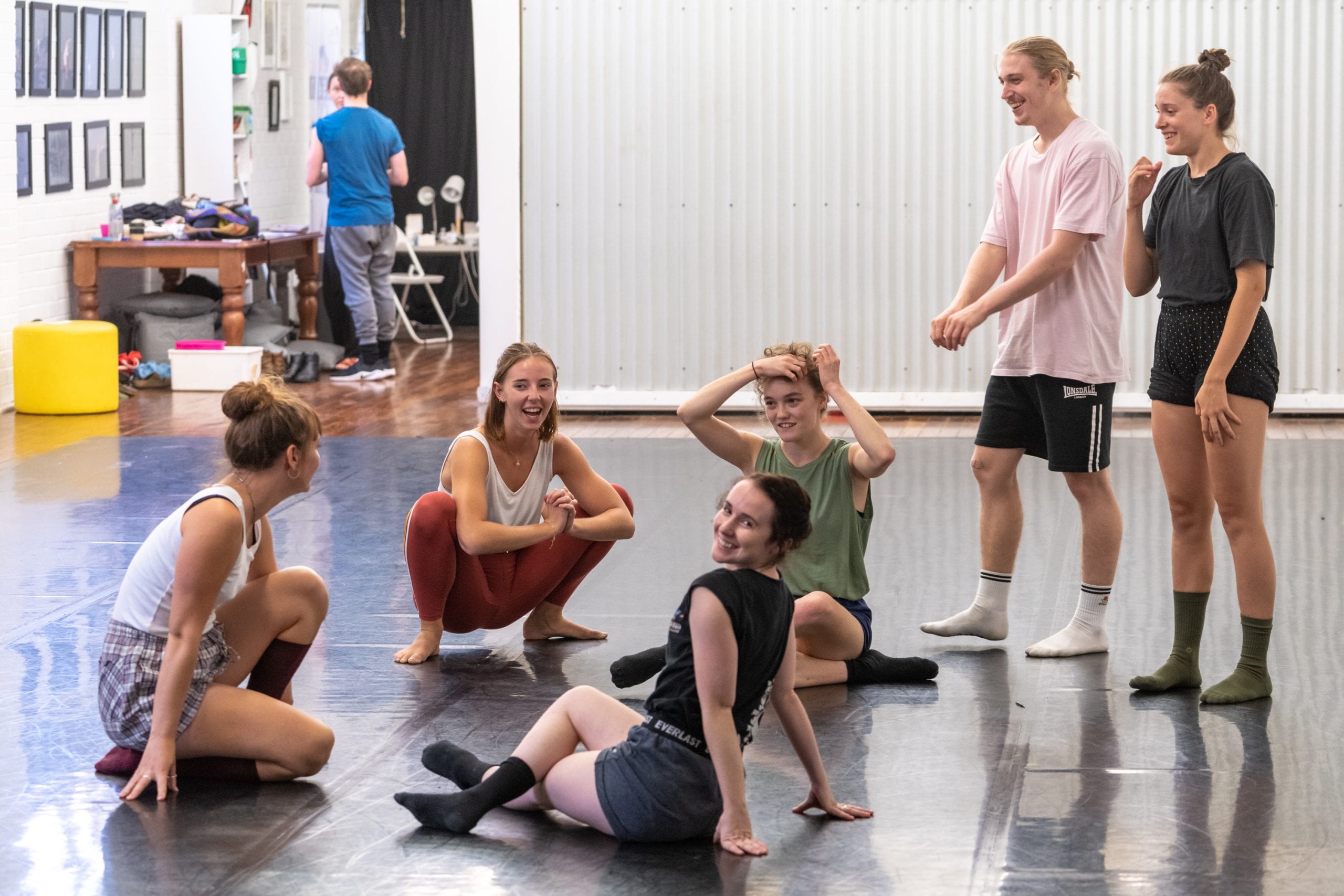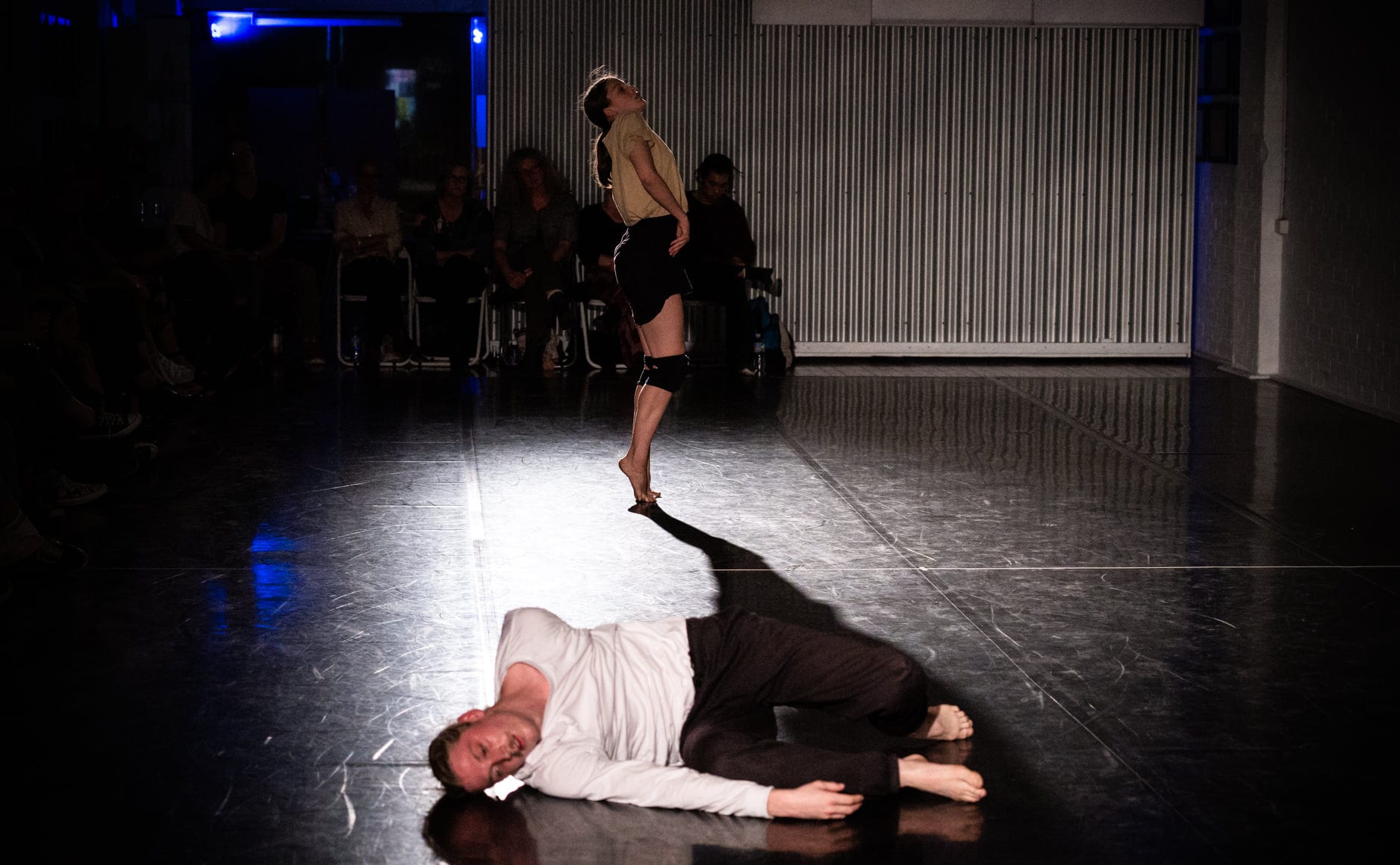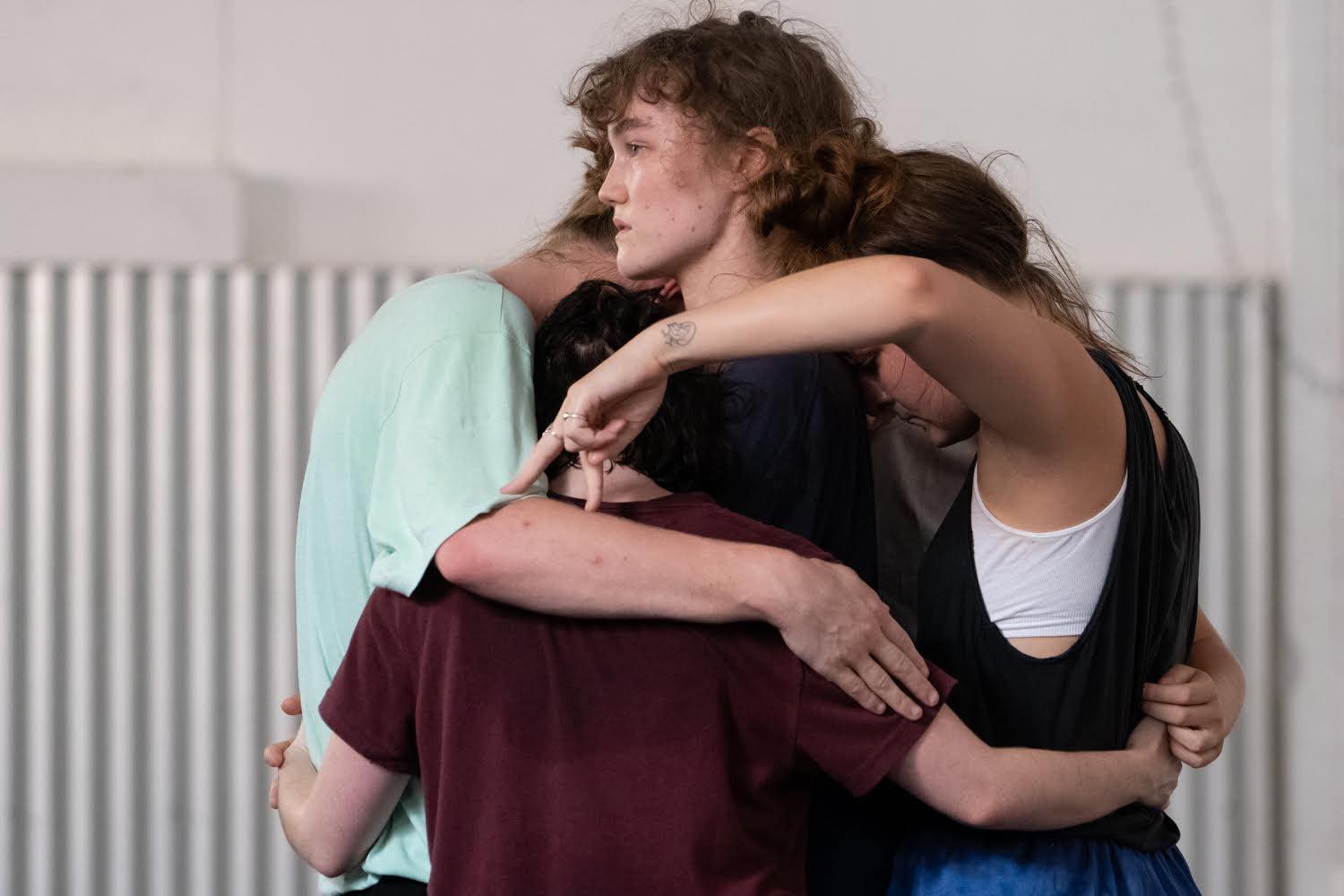MIXED-BILL
BEHIND THE SCENES
TRIP FOR BISCUITS
CHOREOGRAPHER: ADAM BLANCH
COMPOSER: ZACKARI WATT
DANCERS: ELLA DRIENE, ALEXANDRA FORD, ALLIE GRAHAM, NICHOLAS JACHNO, MIKAYLA NANGLE, SKIP WILLCOX
ARTISTIC STATEMENT:
Trip For Biscuits,” a work by Adam Blanch,
explores the endless cycle of chaos and our constant search for purpose. As the curtains rise, the dancers are dressed like they are ready to compete. Red shorts and white singlets, the dancers move chaotically as if searching for a finishing line that doesn’t exist. The choreography is intense and engaging, arms and legs jerk with strength in between moments of softness and fluidity. At one point, a dancer limp with exhaustion falls to the floor while other dancers struggle to pick her up. It is as though her body is succumbing to the fatigue of finding her purpose. The final scene is gripping, the dancers move in a frenzy as the curtains fall around them. Allie Graham is the star of this work, it is hard to take your eyes from her through the entire piece. Claudia Lawson: Fjord Review
‘Trip for Biscuits’, Is A psychological thriller.. The jazzy score composed by Zackari Watt transported the audience to a 1930’s dance marathon and the dancers expressed the multiplicity of the human experience through their disturbingly liquid spines.
Photo Credits: Paul Dear
5 minutes with… Choreographer Adam Blanch Words by Belle Beasley
Having trained at the Australian Ballet and started his career at the Queensland Ballet Company under Francois Klaus, choreographer Adam Blanch seems to have his roots firmly in the classical tradition. However, his unique trajectory from the world of ballet to Sydney Dance Company, Australian Dance Theatre and collaborations with the likes of Akram Khan, might suggest otherwise.
Adam’s piece “Trip for Biscuits” is a dark, visceral and disturbingly reflective work, drawing on the history of dance marathons to explore the internal struggle of a scattered mind. We sit down with Adam to discuss his inspirations as a choreographer and his passion for bringing out the strengths of his dancers.
Questions:
B: So, Adam, tell us a little about the story behind this work? What was the inspiration for this concept?
A: So, the narrative of the piece that the audience will see draws on a film from the late 60’s “They Shoot Horses Don’t They,” which focuses on dance marathons during Depression. However, I have found throughout the choreographic development that this inspiration was speaking to me on deeper level, representing chaos I’ve been experiencing in my own life. I’ve used this story as a metaphor for the human condition, struggling to find clarity in moments of anarchy.
B: Was the approach you took for the creation of this work similar to other pieces you’ve created? How has it been different?
A: I’m someone that really loves to work with the dancers in my team and be inspired by their unique body language. I think from the first day in the studio I was very open to what each dancer brought to the table and this in itself has changed the creation pathway of the work- choreographic process is very collaborative for me.
B: Can you tell us a favourite moment during your creative process with the Catapult dancers?
A: One of the best things about this creative process has been having the chance to work with professional dancers and bring out the best of their abilities through my work. I love to adapt my choreography to the strengths that the dancers have, and complement their natural artistry. Two of the dancers in the cast have been students of mine while they were growing up, and it is in an honour to see them grow and mature into professional artists.
SHIMMERING TOWARDS SILENCE
CHOREOGRAPHER: KRISTINA CHAN
COMPOSER: JAMES HAZEL
DANCERS: ELIZA COOPER, NICHOLAS JACHNO, MIKAYLA NANGLE, SKIP WILLCOX, GEORGIA VAN GILS
ARTISTIC STATEMENT:
Timelines expand and contract deeply. The shimmer of life is palpable. Everything is connected. In an overwhelming psychedelic bliss, we are addicted to her ecology, raising alarms for extinction. The abundance of life gradually becomes silenced, before there was a chance to knowingly describe it.
A minimalists dream; utilising composer James Hazels’ organic and naturalistic score to immerse the audience in a world outside of the theatre. The dancers’ evoked real and surreal elements of the natural environment, moving with a powerful fragility. ‘Shimmering Towards Silence’ presents an elegant outer shell, but this only a momentary illusion: a haunting complexity lays beneath.
5 minutes with…
Choreographer Kristina Chan
Mixed Bill Season: Catapult Choreographic Hub
‘Shimmering Towards Silence’
Written by Belle Beasley
Kristina, having been a long-time collaborator with Catapult Dance Choreographic Hub as both a choreographer and a dancer, felt right at home returning to the Newcastle studios to create her new work “Towards Silence.”
The piece explores the impermanence of nature and its persistence and ability to reform and adapt; a subject that resonates with many, throughout Australia and the world. And yet, Chan uniquely imbues the piece with an appreciation of regrowth and new-life.
We chat to Kristina about life in the studio and choreography in the works.
B: Hi Kristina! Thanks so much for joining us. Please tell the Catapult audience a little about your work new work ‘Towards Silence.’
Thanks Belle. ‘Towards Silence’ is piece that focuses on three ideas, and each idea builds on top of the next. The first looks at the beauty of the natural world and considers both its fragility, and its persistent ability to reform and take new shapes. The second focus is on life cycles that are being silenced by extinction and the drastic environmental changes of our time. The third considers our place as humans as we attempt to coexist a kaleidoscopic world of species and life forces.
B: How exciting. How was the approach you took in creating this work similar or different to previous choreographic developments?
This piece was bound to be different from its birth due to the number of talented movers I had the chance to work with from the beginning- often it’s just me in the studio. To familiarise my dancers with my unique movement vocabulary, we spent the first week experimenting and developing our own expressive language with which to create from. Concurrently, James, the composer was also super connected to my concept which really allowed for a sense of harmony and continuity within the intention of the piece. It felt like a truly collaborative creative process.
B: In what ways do you feel the Catapult dancers have inflected their own unique interpretation on this subject? Has the work taken on a life of its own outside your initial plan?
Coming to Catapult I always feel welcomed and encouraged to explore my boundaries. I have full creative freedom, which is so rare. The team at Catapult have no agenda, so I can really allow my work to form organically and honestly. Furthermore, myself and my dancers know that paid contemporary dance work is few and far between in the current Australian artistic climate, so I can sense that they really approach the rehearsal process with an eagerness to create and gratefulness to the development.
B: Thank you, Kristina, looking forward to the premiere of this work!
Photo Credits: Paul Dear
LADEN BLUE
CHOREOGRAPHER: CRAIG BARY
COMPOSER: ZACKARI WATT
DANCERS: ALEXANDRA FORD, ALLIE GRAHAM, NICHOLAS JACHNO, MIKAYLA NANGLE, SKIP WILLCOX, JESSE MURRAY & KIARN DOYLE
ARTISTIC STATEMENT:
We may hold onto a single performers journey, or view the whole from afar. This work is the feminine, this work is the mother earth.
Our world is laden blue
Once to love with a lot to lose
We made a promise that faded fast
Pushed by pressures thought beyond our grasp
All I need was you on my side
Listening carefully to my sighs
We reveal a heavy truth in this place without you
Because all we ever really had was only you
“The work vividly explore themes of bullying and domestic violence. It is chilling, and perhaps the most striking piece of the night, the audience is completely transfixed. The work begins with the dancers dressed in casual clothes, interacting with each other knowingly. The choreography is cleverly suggestive of relationships between the various dancers, yet fluid enough to make the audience wonder at the work’s direction. As Zachari Watt’s composition builds, the petite and dynamic Alexandra Ford emerges as the star of the work. During the work, she takes to a microphone and sings. Later, with her tiny frame she is pushed and pulled by the other dancers. Dark themes emerge, but the work ultimately lets the audience sit with their own interpretation.” Claudia Lawson: Fjord Review
5 minutes with Belle Beasley
Craig Barys’ new creation for Catapult Dance titled ‘Laden Blue’ is a conceptually layered work dealing with multiplicity of feminine expression through a blend of mediums. The only choreographer within the Catapult Mixed-Bill program to feature audial as well as physical expression, Barys’ work utilises expansive visual and sonic form to create a deep emotional connection to his audience.
B: Hi Craig! Can you tell the Catapult audience a little about these multiple dimensions that exist within your work?
C: The concept of ‘Laden Blue’ is first and foremost drawing on the diversity of feminine expression and physicalising them in an attempt to draw attention to the breadth of possibilities that feminine qualities hold- strength, beauty, aggression, vulnerability, instinctive and primal to name a few. However, I also wanted to use this overarching theme to touch on the relationship between humans and our mother nature, especially in this time of environmental upheaval. The piece is layered, but not overtly.
B: You also employ voice in the piece, with one of the dancers, Alex Ford singing an original song that you wrote and created with composer Zachary Watt. What drew you to this medium for the work?
C: I think I must have been a singer in another life, I’ve always loved songs and thought that singing on stage creates such a new level of vulnerability and humanity for the audience, which is perfect for this piece. I have worked with Alex in New Zealand and knew that she possessed a beautiful voice, so I decided that this would be the perfect chance to bring it out. Very brave of her!
B: Do you see a future for this work after its’ premiere at Mixed-Bill?
This a unique situation for me, usually I’m very content to wrap a work up at the end of a process and allow myself to move on, but this creative process has been so stimulating for me that the idea of continuing and growing the choreography is very appealing. Nothing concrete as yet, but if I had the chance to work with the phenomenal Catapult team again and ‘Laden Blue’ further, I would!
HUMAN REMAINS
CHOREOGRAPHER: OMER BACKLEY-ASTRACHAN
COMPOSER: JAMES HAZEL
DANCERS: ALEXANDRA FORD, ALLIE GRAHAM, NICHOLAS JACHNO, MIKAYLA NANGLE, SKIP WILLCOX
ARTISTIC STATEMENT:
Human Remains is remnants of a dystopian world built on the ruins of what once was a glorious kingdom. A gentle unearthing of broken pieces from the ashes reveals beauty, grace, pain and power.
Backley-Astrachan’s work, Human Remains, focused on a post-apocalyptic theme, where out of the ashes, we as humanity can rise again, exploring the concept of surviving where no other have, and beauty and grace from ashes. There where whiffs of the mythological, presented as a retina of images moving through the work. Animalistic tableau gave resemblance of something familiar, moving into exploration, and sitting in the moment as the dancers wove their way through and developed the idea, whilst morphing from idea to idea. There is a subtle beauty, even in the obtuse, in Backley-Astrachan’s work that pervades the whole work — from the way partnerships are transitioned, to the shapes themselves and the detail within, to the consistent return to motif, which makes for satisfying viewing. There is a brilliance to the partnering work — limbs work sympathetically so that the duo easily slides into a trio or slips into a group encircling each other and then moving into interacting in a completely different manner without the audience being particularly aware of how we got from one to the other. Use of perhaps Hebrew, albeit non-English language, was an interesting feature, with one woman shouting it out as if in countdown, adding the intrigue of the work. Backley-Astrachan knows how to create a world for the dancers to exist within, and the audience is drawn in.
5 minutes with…
Choreographer Omer Backley-Astrachan.
written by Belle Beasley
The new decade has got off to a powerful, visceral and exploratory start with the presence of Omer Backley-Astrachan in the Catapult house.
The Israeli-born choreographer, who now calls Sydney home, brings his unique energy and vision to Catapult to a create brand new work.
Working with five talented dancers of the Catapult company, the piece “Human Remains” touches on the fragmentation of a fragile humanity.
Through Omer’s distinctive choreographic lens, the dancers pull apart and piece back together elements of cultural identity. The work is simultaneously a breaking down, and a rebuilding.
Omer chats to us at Catapult about why this dystopian work is not beautiful- and therefore, is.
QUESTIONS:
B: So, Omer, tell us about the inspiration for this piece? What was your initial stimulus for the birth of this work?
O: Human Remains is a continuation of my work dealing with humanity in this era of turmoil. This refers to my own humanity, as well as that of my dance collaborators. This piece in particular focuses greatly around our shared concern for our planet’s future. Coming from Israel, I also enjoy working from a point of tension between the Australian and Israeli cultures. There are many interesting meeting points and historical overlaps. But despite cultural differences, at a psychological and spiritual level we similar desires and fears. In this work I wanted to see what happens if we divert our focus from the story of the individual which is sometimes our go-to as contemporary artists and concentrate on our shared selves. My inspiration has been to experiment in breaking down some human characteristics such as culture, identity and social structures and then try to glue it back together to see what humanity remained in the end. Well, in the case of this work, not such a pleasant outcome.
B: I see. Have there been elements of this creative process that were previously unexplored?
O: I tackled choreography in a way that was very new to me. We produced heaps of material in the first week without caring too much about what it means. We created an abundance of interesting images and movement phrases. Then the work was created through a process of distillation, refining and layering rather than a linear process of building and adding. This proved extremely enjoyable and also very beautiful.
B: How have you found working with the dancers of Catapult Choreographic Hub? How does the energy within the space and the dancers affect the creative process?
O: I had a profound journey with the five company dancers. This work depended so heavily on their creative input and there was not one day in the process where they didn’t offer their entire world of imagination and playfulness. We laughed, cried, shouted, sang, stomped, spoke and so much more in a space of only three weeks. This was enriched and enabled by the creative input of Artistic Director Cadi McCarthy who joined in many of the rehearsals. The atmosphere in Catapult is cozy and friendly which allows my creative juices to flow. I can’t wait to see this work on stage in only a few weeks’ time.
B: Thanks so much for your time, we are all excited to see this piece come to fruition!
Catch ‘Human Remains’ in Catapult Dance Company’s ‘Mixed Bill.’ Premieres at the Civic Theatre on the 6th of March.
Photo Credit: Paul Dear














